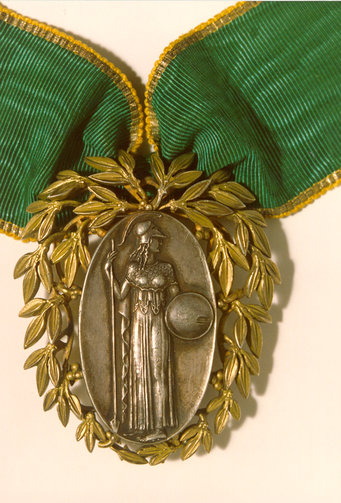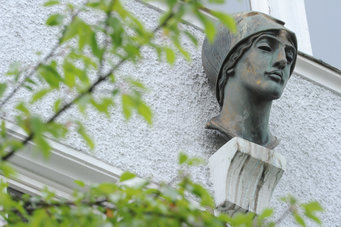A logo and its history
From the portrait of the emperor to the goddess of wisdom - the trademark of the Max Planck Society has a varied history. Since 1926, the head of the Minerva has been the logo of the Kaiser Wilhelm Society. In 1948, it was also adopted by its newly founded successor organization.

Text: Christina Beck
When the Kaiser Wilhelm Society (KWS) was founded in 1911, Wilhelm II intended to shape the symbols of the non-university research organization he had founded. The Society’s members, which comprised famous scientists as well as leaders from industry, the banking world, administration and the nobility, were to be made feel distinguished in a very special way. And so, on 16 January 1911, the Emperor let the Prussian Minister of Culture know: “In order to give the ‘Kaiser Wilhelm Society for the Advancement of Science’, which is under My protectorate, a visual sign of My recognition and goodwill, I hereby bestow upon the members of the Society the right to wear a badge adorned with My image on an orange ribbon interwoven with green in their buttonhole.”
The monarchy came to an end after the First World War in 1918. Nevertheless, it was another eight years before the Kaiser Wilhelm Society finally parted with the Emperor’s portrait on 17 December 1926 at the 14th General Meeting in the Berlin Palace. The membership badge bearing the image of Wilhelm II was replaced by a new one bearing the image of Minerva: the goddess of wisdom, worshipped as the protector of craftspeople, poets and teachers, but also considered the goddess of tactical warfare and combat. Wearing a helmet, holding a downward-pointing spear and bearing a coat of arms, the warrior daughter of Jupiter adorned KWS publications and stationery as an elliptical vignette from 1911. Following a proposal by the Senate, the badge would henceforth be awarded in three different versions: members would wear a gold-plated version on a narrow ribbon in the buttonhole; KWS senators gold-plated versions, but to be worn a broad ribbon around their necks; and prominent figures not belonging to the Society, but who had rendered outstanding services to it, would wear the silver-plated badge on a narrow ribbon in the buttonhole.
Minerva becomes less martial

Max Lucas von Cranach, Managing Director of the KWS, commissioned the Director of the Munich School of Arts and Crafts, Carl Sattler, with designing the badges. Sattler created a more feminine image of Minerva. Her curls were longer and the folds of her robe softer. The Max Planck Society continues to use this standing, slightly modernized version of the goddess on its members’ badges to this day, although it no longer distinguishes between different groups of members. Minerva’s head had been the trademark of the KWS since 1926 and was also adopted by the newly founded Max Planck Society in 1948, which wanted to build on the tradition and reputation of the Kaiser Wilhelm Society. And while the Minerva image of the MPG logo has been modernized over time, this is not the case for the membership badge.
Minerva finally descended from the martial pantheon of the gods in 1956: On the plaque in the entrance to the Max Planck Institute for Chemistry, she has exchanged her shield and spear for a stylus and writing tablet. Busts of Minerva can be found in many variations in most Institutes and, like the bust of Max Planck that has also been erected, have become a unifying symbol.

One particularly impressive object is the six-metre-high sculpture made of dark green granite located in front of the entrance to the Administrative Headquarters in Munich, which portrays Minerva in profile. Sculpted by the Peruvian artist Fernando de la Jara, the goddess’ likeness symbolizes the world of the spirit, ideas, and thoughts. On the opposite side, to the right, is the negative profile, which embodies the world of matter.
In the early 2000s, the internet led to a proliferation of individual sublogos on the MPI websites, but for some years now, the Institutes have been returning to the strength of the umbrella brand. Half of all MPIs now use Minerva exclusively, the other half a double logo consisting of Minerva and the Institute’s own sub-logo.
Note: This article appeared in a printed version in the current issue of our community magazine MaxMag 1/2023.














